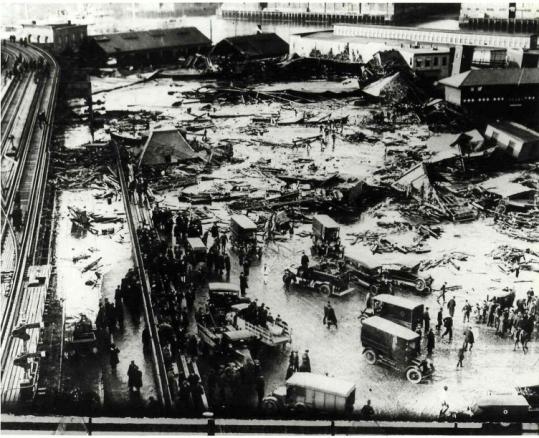

This local folklore is descended from local fact. On the hottest days in Boston, locals claim that the streets bleed it. Additionally, a recent delivery of warm molasses was mixing with the cooler molasses that had been inside the tank for weeks. The Boston Molasses Flood of 1919 27 Jun Molasses is not the most pleasant substance, a thick and dark brown sugary syrup which clings on to anything it touches. 15, the temperature had climbed to about 40°, increasing pressure within the tank. This 'Great Molasses Flood' killed 21 people, injured 150, and had effects far. Two days before the explosion, the temperature was a mere 2° F. 15, 1919, a tank of molasses burst, releasing a thick, sugary tsunami down the streets of Bostons North End. However, the ensuing court case, which lasted more than five years, decided that no act of sabotage had taken place and that structural failure was the cause of the explosion. Moreover, anarchists had bombed USIA facilities in New York several years before, and one employee reported having received a bomb threat against the tank in Boston. The molasses burst from a huge tank at the United States Industrial Alcohol. In fact, the Boston area had experienced 40 explosive incidents in the year leading up to the Molasses Flood. Fiery hot molasses floods the streets of Boston on January 15, 1919, killing 21 people and injuring scores of others.

In theory, the claim was plausible, as anarchists and their dynamiting tactics were common during that time. Industrial Alcohol (USIA) corporation, which owned the Purity Distilling Company that operated the molasses tank, claimed that the explosion was not the result of substandard construction but was instead an act of sabotage perpetrated by anarchists. "Modern day distillers store molasses in small totes of about 275 gallons each, or in stainless steel tanks at larger volumes," he says via email.But the U.S. Jesse Brenneman, co-founder of the Deacon Giles Distillery in Massachusetts explains why a flood of this nature wouldn't even be possible today.

Since the tank wasn't a building or a bridge, there was no regulatory agency responsible for inspecting or regulating it. "The tanks actually broke, because at the time they were made of steel that was too thin, reportedly below standards, even for the time, and the sheer weight of over 2 million gallons of molasses was far too much to bear, eventually causing the tank to fatigue and break, spilling ungodly amounts of molasses out of the warehouse and into the streets." "It's a common misconception that the tanks exploded," says Jamie Windon, owner and co-founder of Lyon Distilling in Maryland, via email. With little in the way of regulation at the time, the Purity Distilling Company tossed together its molasses tank without the benefit of anyone qualified to design so massive a tank. But the reason for the tank's explosion was much more insidious: reckless craftsmanship. 16 edition of "The Boston Globe" suggested that an internal explosion could have been the culprit. Initial reports suggested that anarchists might have blown the massive tank owned by the Purity Distilling Company. 15, 1919, just a year before Prohibition would go into effect, the tank ruptured. Just before the disaster, the tank had been filled close to capacity with a recent shipment of molasses. Later investigation found that the tank wasn't structurally sound to begin with - in fact, it had even been quickly painted brown to hide the fact that it leaked molasses constantly. In 1915 they had erected a massive steel tank, 52 feet (15.9 meters) tall, 90 feet (27.4 meters) across, and able to hold 2.5 million gallons (9.5 million liters) of molasses, which was a prime ingredient for their enterprise. The Purity Distilling Company was a manufacturer of rum and industrial alcohol in Boston's North End.


 0 kommentar(er)
0 kommentar(er)
